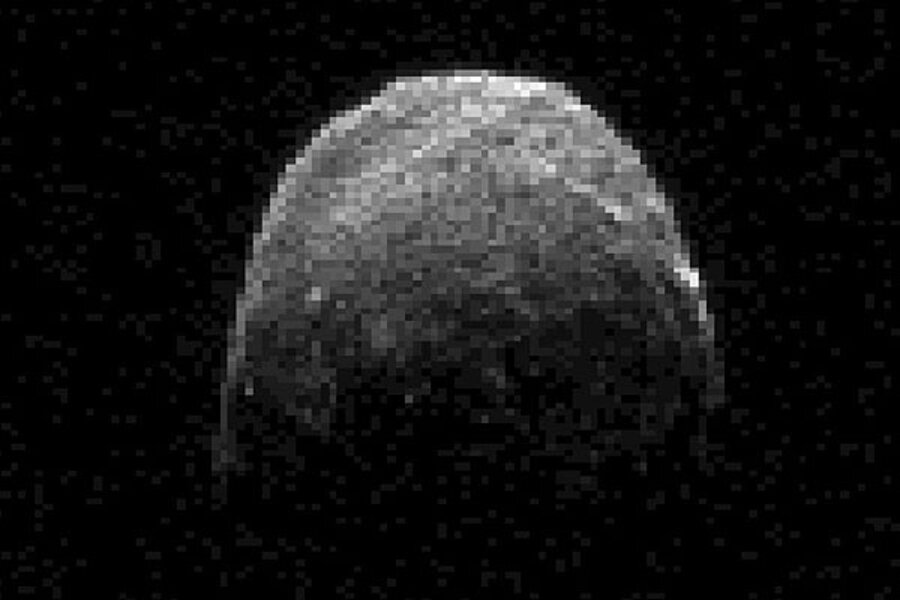Asteroid 2005 YU55: what could be gleaned from its close flyby
Loading...
An asteroid just over four football fields across will flit past Earth Tuesday, providing a unique opportunity for astronomers and a stark reminder that our home planet still orbits in a cosmic shooting gallery.
Known by its formal designation, 2005 YU55, the egg-shaped object is some 1,300 feet across. Its closest approach – at 6:28 p.m., Eastern time – will be roughly 203,000 miles from Earth, just inside the moon's orbital distance.
Discovered and cataloged in 2005, Tuesday's visitor is the largest asteroid to pass this close to Earth with that kind of advance notice, according to Donald Yeomans, a senior research scientist at NASA's Jet Propulsion Laboratory in Pasadena, Calif., and head of the space agency's Near-Earth Object Program Office. Astronomers have thus had time to plan an ambitious observation program for the event.
The last time something of similar size came as close to Earth as 2005 YU55 will was in 1976. The next flyby of a comparably sized asteroid will occur in 2028, when 2001 WN5 will "split the uprights" halfway between the moon and Earth.
Although 2005 YU55 poses no threat of collision on Tuesday or at any time within the next 100 years at least, astronomers have placed it on the "potentially hazardous asteroid" list. They did so because it is so large and does make such close passes. So far, astronomers have tagged 1,246 asteroids with the "potentially hazardous" label.
For astronomers, getting a close look at an asteroid of 2005 YU55's size and type presents a rare opportunity to study a class of objects thought to have contributed organic compounds to a young Earth, according to Joshua Emery, a planetary scientist at the University of Tennessee in Knoxville.
"We are hitting it with everything we can," says Dr. Emery, a member of a team led by the Carnegie Institution of Washington's Nicholas Moskovitz, which has enlisted five large telescopes around the world to observe the asteroid. In addition, astronomers are using two radio telescopes – one in Goldstone, Calif., and the other in Puerto Rico – to build images of the asteroid that could reveal surface features as small as 13 feet across.
Why the interest? 2005 YU55 belongs to a family of carbon-rich asteroids that are thought to be among the most primitive objects remaining from the solar system's planet-forming period some 4.5 billion years ago.
Much of what astronomers have gleaned about these dark-colored asteroids comes from meteorites they have produced.
The meteorites, known as carbonaceous chondrites, have up to 5 percent of their composition tied up in complex organic compounds, including ready-made amino acids. Collisions with carbon-rich asteroids early in Earth's history could have delivered some of the organic compounds that gave rise to life on the planet, researchers say.
Until now, Emery explains, carbon-rich asteroids have been studied from afar using ground-based telescopes. They've tended to be large, dust-covered targets. The dust could be hiding a more telling view of minerals that make up the bulk of these objects.
If 2005 YU55 is dust-free – plausible because it may be so small that its gravity is probably too weak to hang on to any dust that forms – researchers observing the asteroid may get a clearer view of its true composition, Emery says.
That information will feed into a mission that the National Aeronautics and Space Administration approved in May to visit an asteroid and return samples from it. Known as OSIRIS-REx, the mission would launch in 2016, bound for asteroid 1999 RQ36, another carbon-rich asteroid – and one astronomers have identified as a potential risk. Two years ago, a team of astronomers calculated that 1999 RQ36 had eight potential impact opportunities with Earth between 2169 and 2199.
Dust also could be masking important clues on how solidly 2005 YU55 is built, Emery adds. Last year, Japan's Hayabusa mission to asteroid 25143 Itokawa returned samples to Earth. While the craft orbited the potato-shaped asteroid, the science team saw relatively little surface dust – and an object that was more like a rubble pile than a solid chunk of space rock.
"We think that may be related to size," Emery says.
Knowing how solidly built an asteroid is also is important for devising strategies to deflect it if it has Earth in its cross hairs, notes Peter Schultz, a planetary scientist at Brown University in Providence, R.I., who specializes, among other things, in simulating and studying cosmic impacts.
Asteroid 2005 YU55 falls into a class of objects that falls short of busting civilizations, should one strike Earth, he says.
But even if it's largely rubble, an asteroid like 2005 YU55 would retain enough structure after passing through the atmosphere to punch a three- to six-mile-wide crater into Earth's surface.
"That would do some serious damage," he says. The crater could become a bubbling cauldron as ground water flowed into a planetary ding still experiencing high temperatures from the heat of impact. The angle of impact would determine how much of the material that the collision ejected would fall back to the impact site or get kicked into adjacent regions. Dust kicked into the atmosphere could cool surface temperatures around the planet for a couple of years.
If it fell into the ocean, the asteroid would generate tsunamis that would bring unprecedented flooding to regional coasts.
The good news, Dr. Schultz says, is that 2005 YU55 is not going to hit Earth. Indeed, its discovery is a testament to several programs under way to identify and calculate accurate orbits for near-Earth objects, he says.
Still, he says, 2005 YU55's passage between Earth and the moon "is a shot across the bow."





